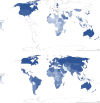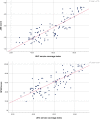An ecological study on the association between International Health Regulations (IHR) core capacity scores and the Universal Health Coverage (UHC) service coverage index
- PMID: 35135576
- PMCID: PMC8822741
- DOI: 10.1186/s12992-022-00808-6
An ecological study on the association between International Health Regulations (IHR) core capacity scores and the Universal Health Coverage (UHC) service coverage index
Abstract
Background: The pandemic situation due to COVID-19 highlighted the importance of global health security preparedness and response. Since the revision of the International Health Regulations (IHR) in 2005, Joint External Evaluation (JEE) and States Parties Self-Assessment Annual Reporting (SPAR) have been adopted to track the IHR implementation stage in each country. While national IHR core capacities support the concept of Universal Health Coverage (UHC), there have been limited studies verifying the relationship between the two concepts. This study aimed to investigate empirically the association between IHR core capacity scores and the UHC service coverage index.
Method: JEE score, SPAR score and UHC service coverage index data from 96 countries were collected and analyzed using an ecological study design. The independent variable was IHR core capacity scores, measured by JEE 2016-2019 and SPAR 2019 from the World Health Organization (WHO) and the dependent variable, UHC service coverage index, was extracted from the 2019 UHC monitoring report. For examining the association between IHR core capacities and the UHC service coverage index, Spearman's correlation analysis was used. The correlation between IHR core capacities and UHC index was demonstrated using a scatter plot between JEE score and UHC service coverage index, and the SPAR score and UHC service coverage index were also presented.
Result: While the correlation value between JEE and SPAR was 0.92 (p < 0.001), the countries' external evaluation scores were lower than their self-evaluation scores. Some areas such as available human resources and points of entry were mismatched between JEE and SPAR. JEE was associated with the UHC score (r = 0.85, p < 0.001) and SPAR was also associated with the UHC service coverage index (r = 0.81, p < 0.001). The JEE and SPAR scores showed a significant positive correlation with the UHC service coverage index after adjusting for several confounding variables.
Conclusion: The study result supports the premise that strengthening national health security capacities would in turn contribute to the achievement of UHC. With the help of the empirical result, it would further guide each country for better implementation of IHR.
Keywords: International Health Regulations (2005); Joint External Evaluation; States Parties Self-Assessment Annual Reporting; Universal Health Coverage.
© 2022. The Author(s).
Conflict of interest statement
The authors declare that they have no competing interest.
Figures
Similar articles
-
Evaluating implementation of International Health Regulations core capacities: using the Electronic States Parties Self-Assessment Annual Reporting Tool (e-SPAR) to monitor progress with Joint External Evaluation indicators.Global Health. 2021 Jun 30;17(1):69. doi: 10.1186/s12992-021-00720-5. Global Health. 2021. PMID: 34193187 Free PMC article.
-
Lack of Alignment Between WHO Joint External Evaluation and State Party Self-Assessment Scores Undermines Utility as Evaluation Tools for the Department of Defense.Health Secur. 2022 Jul-Aug;20(4):321-330. doi: 10.1089/hs.2021.0209. Epub 2022 Jul 26. Health Secur. 2022. PMID: 35881868
-
Is countries' transparency associated with gaps between countries' self and external evaluations for IHR core capacity?Global Health. 2020 Jan 20;16(1):10. doi: 10.1186/s12992-020-0541-3. Global Health. 2020. PMID: 31959196 Free PMC article.
-
Learning from COVID-19: A Systematic Review of the IHR-SPAR Framework's Role in the Pandemic Response.Int J Environ Res Public Health. 2025 Apr 27;22(5):695. doi: 10.3390/ijerph22050695. Int J Environ Res Public Health. 2025. PMID: 40427812 Free PMC article.
-
Assessing public health preparedness and response in the European Union- a review of regional simulation exercises and after action reviews.Global Health. 2023 Oct 28;19(1):79. doi: 10.1186/s12992-023-00977-y. Global Health. 2023. PMID: 37898790 Free PMC article. Review.
Cited by
-
Construction of public health core competence and the improvement of its legal guarantee in China.Front Public Health. 2023 Feb 20;11:1125591. doi: 10.3389/fpubh.2023.1125591. eCollection 2023. Front Public Health. 2023. PMID: 36891339 Free PMC article.
-
Universal health coverage-Exploring the what, how, and why using realist review.PLOS Glob Public Health. 2025 Mar 18;5(3):e0003330. doi: 10.1371/journal.pgph.0003330. eCollection 2025. PLOS Glob Public Health. 2025. PMID: 40100795 Free PMC article.
-
The role of universal health coverage and global health security nexus and interplay on SARS-CoV-2 infection and case-fatality rates in Africa : a structural equation modeling approach.Global Health. 2023 Jul 6;19(1):46. doi: 10.1186/s12992-023-00949-2. Global Health. 2023. PMID: 37415196 Free PMC article.
References
-
- Pan American Health Organization (PAHO). International Health Regulations (IHR) - PAHO/WHO [Internet]. [cited 11 Aug 2021]. Available from: https://www.paho.org/en/international-health-regulations-ihr.
-
- Razavi A, Collins S, Wilson A, Okereke E. Evaluating implementation of International Health Regulations core capacities: using the Electronic States Parties Self-Assessment Annual Reporting Tool (e-SPAR) to monitor progress with Joint External Evaluation indicators. Globalization and Health. 2021;17(1):1–7. - PMC - PubMed
-
- World Health Organization (WHO). International Health Regulations (2005) - IHR Monitoring and Evaluation Framework [Internet]. World Health Organization; 2018 [cited 11 Aug 2021].
-
- World Health Statistics 2017: Monitoring health for the SDGs, sustainable development goals [Internet]. World Health Organization; 2017 [cited 11 Aug 2021]. Available from: https://apps.who.int/iris/handle/10665/255336.
Publication types
MeSH terms
Grants and funding
LinkOut - more resources
Full Text Sources
Medical




